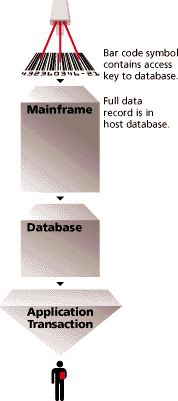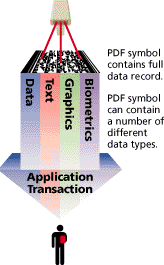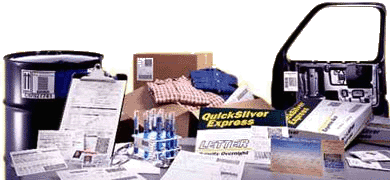PDF417: The Specific Barcode for Data Management Applications
Komeil Bahmanpour, Sadjad Bahmanpour
Chortkeh Rayaneh Hamrah, LLC
November 2002
Information Transfer in a Whole New Dimension
Imagine a database that’s totally portable, freed from the computer to go anywhere and yet be accessed immediately at any time. Or a paper-based communication medium that makes documents, labels and cards “live” with machine-readable information, including text, graphics, biometrics or other data. And imagine capturing this information quickly, easily and inexpensively. There’s a technology that offers all this, and it’s here today: it’s PDF417.
PDF stands for Portable Data File. A two-dimensional symbology, a single PDF417 symbol carries up to 1.1 kilobytes of machine-readable data in a space no larger than a standard barcode. And, unlike traditional one-dimensional barcodes, which depend on real-time links to a larger database, PDF417 symbols are the database. PDF417 symbols travel on paper, packages or parts, with people, too.
PDF417 technology translates into productivity. Easy to use and easy to integrate, a PDF417 application delivers the benefits of digital data communications with the simplicity of barcoding. It’s very low in cost, printable in various sizes on a wide variety of media using traditional printing technologies, easy to support, and highly robust in its error correction capabilities. Moreover, PDF417 has been recognized as the standard among two-dimensional symbologies by leading organizations worldwide.
Equally important, any business, government agency or service organization must be assured of a low-risk, long-term return on its technology investment. PDF417 scanning equipments can also read all conventional one-dimensional barcodes, assuring compatibility with your installed barcode systems.
PDF417: Much More than Meets the Eye
PDF417 answers the need to capture, store and transfer large amounts of data inexpensively. It can exchange complete data files (such as text, numeric, or binary) and encode graphics, fingerprints, shipping manifests, electronic data interchange (EDI) messages, equipment calibration instructions, and much more. It provides a powerful communications capability, without the need to access an external database. And, for virtually no incremental cost, you can add a PDF symbol to the documents and labels you are already printing.
Think of PDF as an independent database with complete freedom of movement, traveling together with a person or on an item, object, package, form, document, card or label. It does what wired networks can’t: allows you to immediately access your data regardless of location. Plus, encryption is available as an option when additional security is required.
Moreover, because PDF417 is a machine-readable method of transporting data, it eliminates time-consuming and error-prone manual data entry. It functions as a paper-based computer memory that can be written once and read over and over again. And, as a universal machine language, it communicates with all host operating systems. PDF417 encodes full ASCII, numeric or binary data and it uses sophisticated error correction algorithms to keep intact 100 percent of the data, even when as much as half the symbol is damaged. And it’s self-verifying, so data errors can be detected and data integrity maintained. All of the rewards of leading-edge technology with none of the risks. Benefits like these are well worth capturing today.
What a Difference a Dimension Makes
One-dimensional barcodes contain an access code that serves as a real-time key for opening a database. A PDF417 symbol contains a complete data record and requires no access to an external database. Data, text, graphics, biometrics and voice records are immediately applied to the application transaction by simply scanning the symbol.


A Technology You Can Trust
PDF417 is the de facto standard 2-D symbology. In addition to its performance capabilities and application value in a wide range of industries, PDF417 technology is in the public domain and it conforms to industry and international open standards. For all of these reasons, PDF417 is emerging as the standard 2-D symbology by leading standards-setting organizations:
- The American National Standards Institute (ANSI) has just published a new 2-D standard: ANSI MH 10.8.3M unit loads and transport packages for two-dimensional symbols. It recommends the use of PDF417 for all shipping, receiving and supporting EDI documentation. Most standards associations will use this ANSI standard as the basis for their specific industry’s application specification.
- AIM USA and AIM Europe, accredited ANSI standards-developing organizations, which have approved and published PDF417 as a Uniform Symbology Specification (USS) standard.
- The U.S. Department of Defense, which has designated PDF417 as the standard 2-D barcode for logistics applications and EDI formatting on paper labels.
- The American Association of Motor Vehicle Administrators (AAMVA), which has approved and published PDF417 for a broad range of driver and motor vehicle applications.
- The Automotive Industry Action Group (AIAG) 2-D Applications Committee, which has selected PDF417 for its key 2-D production and logistics applications, is completing their B-10 standard for shipping and receiving.
- The Telecommunication Industry Forum (TCIF) is reviewing PDF417 as the 2-D standard for product marking.
- The U.S. Department of Defense, Office of Personnel and Readiness, has issued millions of military identification cards with PDF417 symbols for use on a global basis.
Verified in Independent Testing
Not only is PDF417 technology hard at work in a wide range of important applications, it has also been proven in independent testing:
- In reliability testing by the Ohio University Center for Automatic Identification, 32 million PDF417 characters were read without an error.
- Tests at the University of Pittsburgh proved PDF417 compatibility in high-speed overhead scanning and its readability even when symbols were damaged.
Technology that’s Proven in Diverse Applications
Just about everyone in the private and public sectors is in the business of information, communication, identification and data management. PDF417 symbology serves all of these needs and has been proven in a highly diverse range of end user applications.
PDF: Expanding on Your Barcode Capabilities
The two-dimensional benefits of PDF417 symbols are ideal for applications that are limited by the natural constraints of 1-D barcodes. The amount of data needed as well as the environment it exists in are key deciding factors when choosing to implement a system using 2-D symbols. A single scan of a PDF417 symbol can easily replace multiple 1-D barcodes while delivering more information more quickly.
In addition, the PDF417 symbols were developed to survive in tough environments. Robust by design, these symbols use an error correction algorithm to correct lost or missing data for damaged symbols. Up to half of the symbol can be destroyed or missing, yet it can still be decoded.
| Government | Retail | Transportation | Health | Manufacturing |
| Identification cards (national ID, military ID, social services) Motor vehicle licenses and registrations Public safety including citations, vehicle inspections, and accident reporting Logistics Official documents Border/passport/customs control Asset management |
Manifesting for shipping and receiving EDI Inventory control Direct mail marketing Shopper loyalty programs Returns processing Warranty tracking |
Bills of lading Package tracking EDI Shipping manifests |
Laboratory requisition processing Specimen tracking Claims processing Identification cards Reagent calibration |
Process control Equipment calibration Asset tracking Hazardous material control Quality control Maintenance records Configuration management |

Flexible Technology that Adapts to You
Unlike some new technologies, PDF417 doesn’t require users to learn different procedures, abandon existing hardware or software, or commit to costly reinvestment in facilities or systems. A PDF417 solution can often be added with little change to current applications and it can make use of existing printers and other equipment.
It’s compatible with all the same printers used to print 1-D barcodes, including laser, thermal direct, thermal transfer, inkjet and others, and all are widely available today. Mainframe solutions are also available for high-speed printing applications. You can print on a wide variety of materials: paper, cards, labels, plastics, metals and others. Even you can fax it.
Total Support, Total Solutions
We can provide solutions to all of your 2-D product needs, but that’s just the beginning, because behind PDF417 stands an extensive infrastructure of support programs and system integration that can deliver total customer solutions.